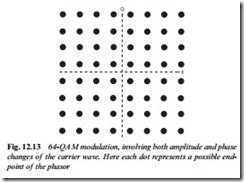64-QAM
Cable TV distribution systems are based on coaxial (copper) and fibre-optic cables in which signal levels are closely controlled, and the noise level is relatively low. These conditions are best served by the 64-QAM modulation system, in which the carrier can be varied in both phase and amplitude to render 64 different states as shown in Fig. 12.13, and thus 64 different symbols. The result is a higher ‘packing density’ of data.
The cable system needs good differential phase performance (time delay versus amplitude) for 64-QAM to work well. The main vulnerability to data corruption is from signal reflections which can arise in cable systems due to tolerances in terminating impedances at repeaters and consumer outlets. To counter this, special coding systems are used to give a high margin of error protection and correction.

